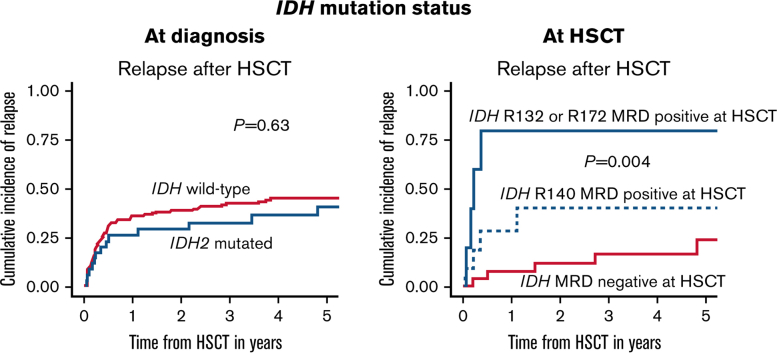- Record: found
- Abstract: found
- Article: found
Impact of IDH1 and IDH2 mutation detection at diagnosis and in remission in patients with AML receiving allogeneic transplantation

Read this article at
Key Points
Visual Abstract
Abstract
Somatic mutations in the isocitrate dehydrogenase 1 and 2 genes ( IDH1 and IDH2) are common in acute myeloid leukemia (AML). The prognostic impact of the presence of IDH mutations may be influenced by the comutational status, the specific location of the mutation (ie, IDH1 R132, IDH2 R140, and IDH2 R172) at diagnosis, and the dynamics of the mutation burden during disease course. Even though many patients with IDH-mutated AML are consolidated by hematopoietic stem cell transplantation (HSCT), the underlying biology and prognostic consequences remain largely unknown. Here, we present a large analysis of 292 patients with AML who received HSCT in complete remission (CR) or CR with incomplete peripheral recovery (CRi), in which we assessed the IDH mutation status at diagnosis and HSCT as a potential marker for measurable residual disease (MRD). About a quarter of all patients were IDH-mutated at diagnosis. The diagnostic presence of IDH mutations in AML did not have a significant prognostic impact when consolidated with HSCT. However, IDH1 R132 and IDH2 R172 MRD positivity in remission at HSCT associated with an increased risk of relapse, while IDH2 R140 mutations did not. The IDH2 R140 variant allele frequency (VAF) at diagnosis was higher, clustering around 50%, and the mutation clearance at HSCT in morphologic remission was much lower compared with IDH1 R132 and IDH2 R172. In our cohort, IDH2 R140 mutations behaved more like a clonal hematopoiesis-related aberration, while IDH1 R132 and IDH2 R172 harbored AML disease-specific features.
Related collections
Most cited references35
- Record: found
- Abstract: found
- Article: not found
Diagnosis and management of AML in adults: 2017 ELN recommendations from an international expert panel.
- Record: found
- Abstract: found
- Article: not found
Genomic Classification and Prognosis in Acute Myeloid Leukemia
- Record: found
- Abstract: found
- Article: not found
